Gateway ID49: Mixing the Bag
by Dustin Sklavos on September 23, 2010 2:46 AM ESTLow and Medium Gaming on the ID49C
The benchmarks we run in our gaming suite should provide some fairly interesting results, especially in placing the NVIDIA GeForce GT 330M's relative performance against the 325M and 335M. The 325M sports 48 "CUDA cores" and a 128-bit memory bus just like the 330M, but at lower clock speeds, while the 335M moves up on the food chain and uses a harvested GeForce GT 240 die, running at slightly lower clocks than the 330M but bumping up to 72 shader cores.
There's a caveat to these results, however: for StarCraft II we had to manually tweak the display drivers to get Optimus to work with it (before we did the game ran at a constant 4fps, which is slow even for Intel's HD Graphics.) Also, there seems to be a bug with Optimus in Left 4 Dead 2 using the latest 260.63 drivers, where setting the game to 4xAA results in a blank screen. Unfortunately, we couldn't get the ID49C to run L4D2 with 4xAA on the 258.96 drivers either, something which wasn't an issue on the ASUS N82Jv. Those test results—for our "High" preset—are mostly academic as the 330M really isn't powerful enough to be pushing anti-aliasing anyhow, but it bears mentioning nonetheless.
Of course, all of this is going to be rendered fairly meaningless soon enough: GeForce 400M series parts should start trickling in soon, and hopefully they'll bring the kind of performance improvements NVIDIA has desperately needed on the mobile front. Optimus is a great technology AMD just doesn't have a counter for right now, but AMD's mobile parts are generally faster in their given classes. Hopefully with the 400Ms NVIDIA will be able to give us everything: better performance, DX11 support, and better battery life thanks to Optimus.
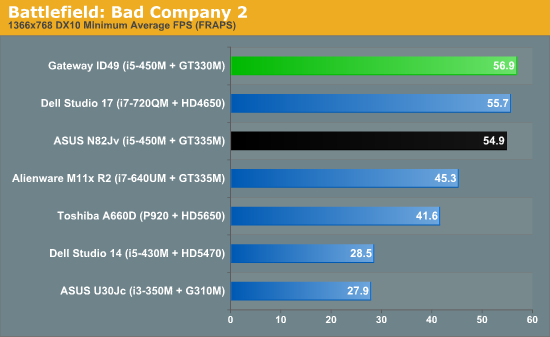
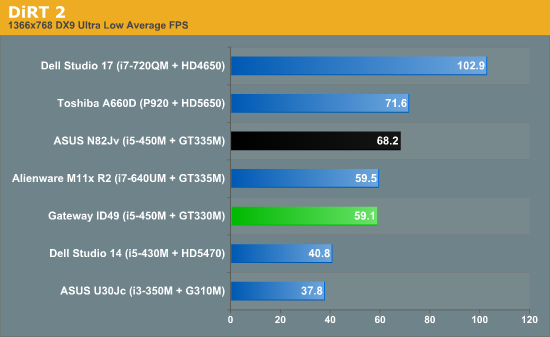

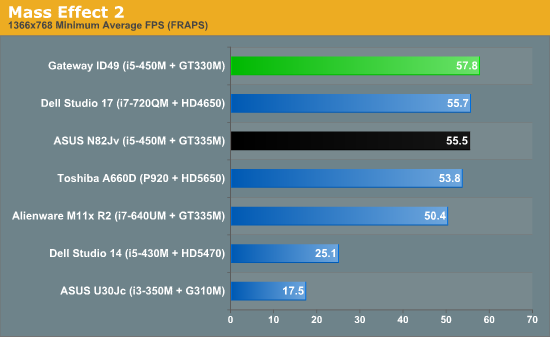

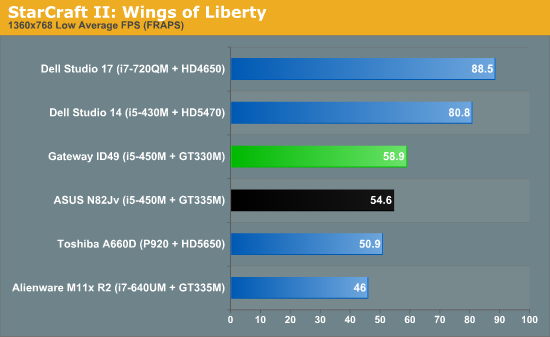
At these minimal settings, the GeForce GT 330M in the ID49C is able to post playable framerates on every game in our suite with room to spare. In most cases the testing units seem to be CPU limited, though the GeForce G 310M and Mobility Radeon HD 5470 are so anemic to begin with that even at minimal settings they threaten to bog down gaming performance. The exception is StarCraft II, where for whatever reason the Radeons seem to take it to the GeForces. The only Radeon not posting framerates over 80 is the HD 5650 in the Toshiba A660D, hamstrung by a slow Phenom II in a game traditionally CPU limited at even the highest settings. Also somewhat interesting is that the ID49C manages to best the GT 335M in the N82Jv in several games, despite sharing the same CPU. We'll see that once we up the quality settings, the GT 335M is able to take the lead.
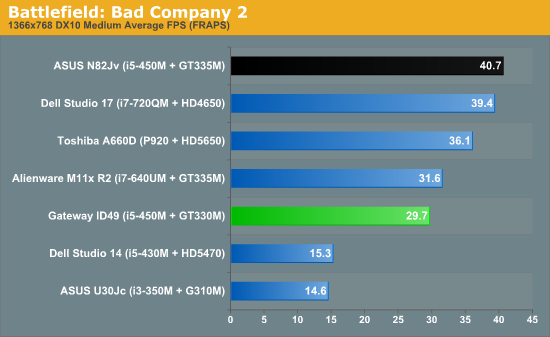
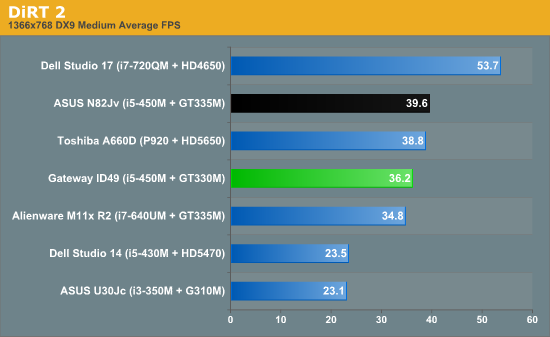
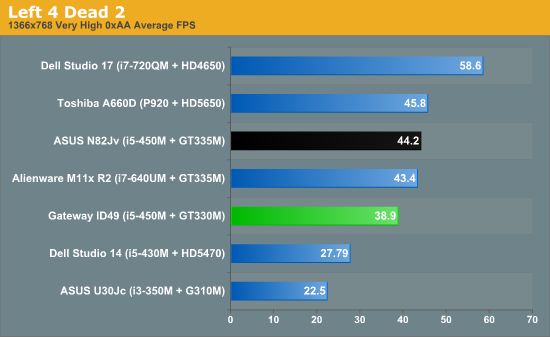
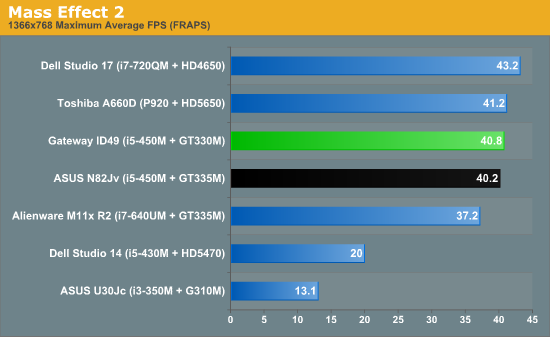
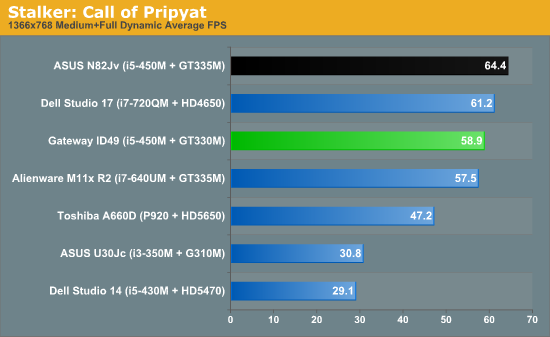
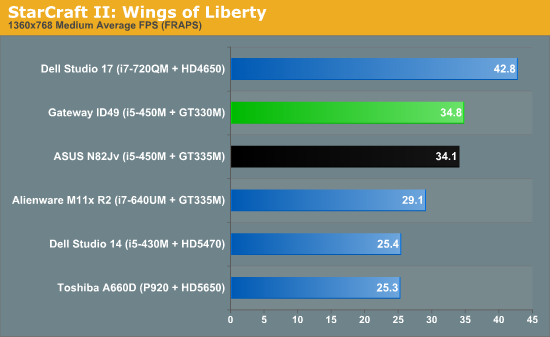
Once we start to ratchet up graphics settings, our testing suite starts to separate the men from the boys, and it's here that the GeForce GT 330M unfortunately exposes the weak link in Nvidia's current (and thankfully soon to be retired) mobile lineup. The GT 330M is extremely common, but it consistently loses to the Mobility Radeon HD 4650. The 4650 is an old chip; when it dropped it was an absolute powerhouse for the market segment, but it's been around for nearly two years, and Nvidia is only just now getting around to answering it with the 400M series. Even the GT 335M has problems with it.
Taken in a vacuum, the 330M is able to produce playable framerates in every game we tested it in, but it doesn't have much headroom. Its bigger brother, the 335M, and AMD's newer Radeon HD 5650 both come out looking pretty bad too. The 5650 proves itself as an incremental at best upgrade over the 4650, although it's important to keep in mind that the A660D is CPU-limiting it and worse, the 5650 itself is clocked 100MHz below spec in that unit. But the 335M, despite having a 100MHz slower clock speed has 72 shaders instead of the 330M's 48, and it still barely holds a lead, likely because both parts have the same memory bandwidth.










43 Comments
View All Comments
Pirks - Saturday, September 25, 2010 - link
hahaha, I immediately pictured the Mototroll frothing and spitting at his screen after reading this, LOLOL :))))synaesthetic - Saturday, September 25, 2010 - link
I use a Gateway laptop with Gateway's more-squared-off variant of Acer's FineTip keyboard. I don't find it that horrible. My typing speed on it is actually faster and more accurate than your standard desktop keyboard.I mean, it's no Thinkpad keyboard, but it's a hell of a lot less shitty than some keyboards I've used.
And the keyboard on my NV5925u is rock-solid everywhere except for a very SLIGHT amount of flex above the optical drive bay (where the numeric keypad resides).
Classic Rock - Sunday, November 7, 2010 - link
I just made an account because of this review. It is just that good, I laughed my arse off. I love the honesty, the brutal honesty : )Too many reviewers gloss over the small / minor bad things about a system. I like how you bring the bad out into the open here. It's brilliant.